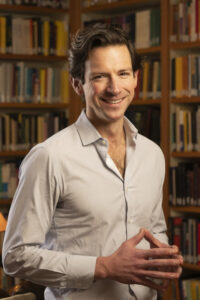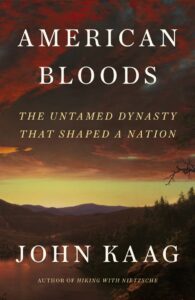Philosophy professor John Kaag has a lot of fun in his latest book, American Bloods: The Untamed Dynasty That Shaped a Nation. He tells the stories of selected members of the Blood family, whose colonial forebears built a farmhouse on the outskirts of Concord in what is now the town of Carlisle. That house is currently the home of the author, his wife, and their two young children.

Kaag is chair of the philosophy department at the University of Massachusetts Lowell. He specializes in 19th-century philosophers and has said in interviews that he counts Ralph Waldo Emerson, Henry David Thoreau, and William James among his heroes.
He is a prolific writer and has received much praise for his books, several of which have chronicled his divorces and his obsession with long-distance running. These include American Philosophy: A Love Story (2016), Hiking With Nietzsche: On Becoming Who You Are (2018), and Sick Souls, Healthy Minds: How William James Can Save Your Life (2020).
Now comes American Bloods, another book blending scholarship and memoir, published by Farrar, Straus and Giroux on May 14. Many readers will no doubt find Kaag’s book delightful, taking pleasure in his digressions into philosophy and intellectual history. But I struggled with the book for several reasons, including its speculative overreaches and clunky framing device. I was also put off by Kaag’s inconsistent use of terms readers may not understand as contested when it comes to the histories of Indians and Blacks.
Kaag tells the stories of the American kin of Thomas Blood, an English chancer who thrived in 17th-century London despite having stolen the crown jewels. In a riveting first chapter focused on this Blood, Kaag uses his story to explore the English Civil War and early New England’s colonial inhabitants.
This is just the first of several good yarns Kaag tells in subsequent chapters as he examines the lives of various Bloods who appeared at inflection points in American history: colonial settlement, the War of Independence, the Industrial Revolution, the explosive conflict in Kansas before the Civil War, and the rise of the Robber Barons.
I have three favorite chapters in American Bloods, including a beautifully written one about Perez Blood. He and his sisters never married. They lived in Concord in the 1840s in a fashion Thoreau found inspiring. Perez bought a telescope, and Thoreau visited to look through its lens. Thoreau took Perez to Harvard to check out books on astronomy. Their friendship, Kaag argues, helped Thoreau articulate his philosophy of transcendentalism.
In the next chapter, Kaag brilliantly tells the rags-to-riches story of Aretas Blood, who became one of America’s most important producers of railroad cars before, during, and after the Civil War. In Aretas, Kaag truly has found a Blood who helped define antebellum America. I also loved Kaag’s wild ride of a chapter near the book’s end that brings spiritualist and free love advocate Victoria Woodhull into the Blood family’s sprawl.
These small gems make American Bloods a pleasure, but Kaag positions the book in ways that troubled me.
He overreaches, I believe, when he makes all-embracing claims that the Blood family “shaped a nation.” It would be more accurate to say that Kaag has identified some members of the Blood family whose stories can help readers understand how America came to be. By telling those stories, Kaag identifies important currents in American history — especially American intellectual history. But his conjectures frequently include words such as “perhaps,” “suggests,” and “may have.” That’s a sign that Kaag is making too much of too little, leaving me less inclined to accept his claims about his characters’ significance.
In this vein, the author’s interest in “the spiritual” moves him away from history and toward Henry James’s The Turn of the Screw. Kaag frames American Bloods with two stories. In one, he sees what he concludes is a spectral wolf in the swampy forest behind his house. He knows that wolves don’t live in the woods of exurban Carlisle, but he nonetheless believes that the wolf is real. His belief leads to a decision to open each chapter with an epigraph mentioning wolves. By the third chapter, I felt Kaag had gone one wolf too far.

Kaag explains that he relied on the work of others to write American Bloods. In one footnote, he writes, “In some cases, the study of the Bloods was initiated in a family genealogy, privately published.” That genealogy is Roger Deane Harris’s The Story of the Bloods, which set Kaag on his wild wolf chase.
After his encounter with the wolf/not wolf, Kaag — late at night, holding a flashlight — finds a “bag filled with a stack of yellowing paper.” It’s Harris’s genealogy, which includes descriptions of the more interesting members of the Blood family as well as a tangled genealogical web of Blood kin. Kaag describes this discovery as “spooky.”
Kaag may well have been spooked. But I found the same book in about two minutes, and with no mystery, by searching for it in the Internet Archive.
More problematic in his project of writing an overarching history of America is Kaag’s casual use of freighted words like “wild,” “frontier,” “pioneer,” “New World,” “civilization,” and “tame.” Over the last 40 years, American environmental, labor, social, and cultural historians have worked hard to illuminate the biases implied by such words; in the present political moment, a decision not to do so strikes me as dangerous.
Several histories of American families that are more careful in their use of loaded words come to mind. They include books by Edward Ball, John Demos, Anne Hyde, Tiya Miles, and Laurel Thatcher Ulrich. All are rooted in creative archival work and sometimes rely on speculation. They aren’t memoirs or books about philosophy, so they are different projects from Kaag’s American Bloods. But readers who wish to explore such histories will encounter in them families that truly did shape our nation.
